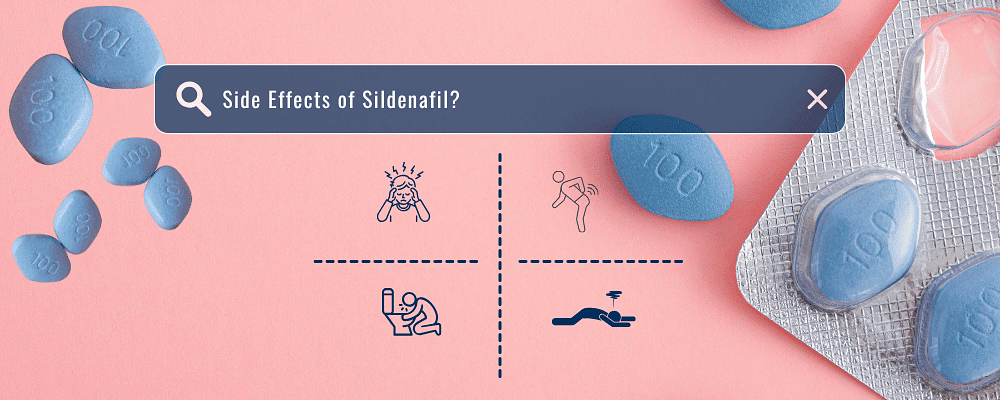What Are the Side Effects of Sildenafil? Comprehensive Medical Review (2025)

Sildenafil, the generic version of Viagra and many other generics, is also the most prescribed drug for erectile dysfunction (ED). Although very effective for most, it is essential to be aware of sildenafil side effects for safe and informed use, particularly with the increased global availability through telehealth websites and over-the-counter outlets in some areas.
This guide offers tiered summaries of sildenafil side effects, examines pharmacological mechanisms, and compiles existing evidence-based safety practices. With fresh perspectives from 2025 pharmacovigilance data and regulatory changes, it's intended to assist patients and physicians in making informed decisions.
Setting the Clinical Context
Erectile dysfunction affects over 150 million men worldwide and is projected to rise significantly due to aging populations and lifestyle-related comorbidities. Sildenafil was initially created to treat angina. However, it changed the management of erectile dysfunction following its FDA approval in 1998. Its subsequent generic versions have made it widely available and affordable.
Due to its extensive use, both common and rare adverse events deserve thorough attention. Updated safety data from post-marketing surveillance, particularly through FDA MedWatch and the European Medicines Agency (EMA) in 2025, continue to refine our understanding of sildenafil side effects in real-world populations.
How Sildenafil Works – Why Adverse Reactions Occur
Sildenafil is a phosphodiesterase type 5 (PDE-5) inhibitor. By blocking PDE-5, it enhances the nitric oxide (NO)-cyclic guanosine monophosphate (cGMP) pathway, resulting in vasodilation, primarily in the corpus cavernosum of the penis. This facilitates improved blood flow and erectile function in response to sexual stimulation.
However, PDE-5 is not exclusive to penile tissue. Off-target pharmacologic effects in systemic vascular beds, ocular tissue (PDE-6), and smooth muscles can lead to unexpected side effects, including hypotension, visual disturbances, and headaches.
Tier 1 – Very Common & Common Reactions (Incidence > 1 in 10)
Sildenafil side effects most often fall into this category and are generally mild to moderate in severity. These are typically transient and dose-dependent:
Headache: Reported in up to 16% of users due to cerebral vasodilation.
Flushing (facial or upper torso): Caused by peripheral vasodilation.
Dyspepsia: Indigestion or gastric discomfort from smooth muscle relaxation.
Nasal Congestion: A result of mucosal vasodilation.
Back Pain: Possibly linked to muscle relaxation or altered posture post-intercourse.
Visual Tinting (blue vision or light sensitivity): Due to mild PDE-6 inhibition in retinal photoreceptors.
These common sildenafil side effects typically resolve within a few hours. Drinking water and taking the medication with a light meal may reduce discomfort.
Tier 2 – Uncommon But Clinically Relevant (Incidence 1 in 100 to 1 in 1,000)
While less frequent, these effects may impact user comfort or adherence:
Dizziness and Nausea: Often tied to transient blood pressure drops. You can also feel nausea from sildenafil.
Tachycardia: Reflex increase in heart rate due to systemic vasodilation.
Transient Hypotension: Particularly in those sensitive to vasodilators.
Blurred Vision and Photophobia: Minor visual disturbances lasting less than 2 hours.
Mild Epistaxis: Rare nasal bleeding associated with mucosal dilation.
Myalgia: General muscle aches or stiffness, usually in the back or limbs.
If these reactions recur, consider adjusting the dosage or evaluating for underlying health issues.
Tier 3 – Rare & Serious Adverse Events (Incidence < 1 in 10,000)
Though rare, these sildenafil adverse reactions require urgent evaluation or discontinuation of therapy:
Priapism (Erection > 4 Hours): A urologic emergency that can result in permanent damage. Immediate medical attention is essential.
Non-Arteritic Anterior Ischemic Optic Neuropathy (NAION): Sudden, painless vision loss. More common in those with vascular risk factors.
Sudden Sensorineural Hearing Loss: Abrupt hearing impairment, sometimes accompanied by tinnitus or vertigo.
Cardiovascular Collapse (with Nitrates): Dangerously low blood pressure can occur when sildenafil is taken with nitrates or riociguat.
Severe Dermatologic Reactions (e.g., Stevens-Johnson Syndrome): Extremely rare, but life-threatening skin reactions have been reported.
All users should be counseled about these rare but severe possibilities and advised to discontinue use immediately if symptoms arise.
Drug–Drug & Drug–Disease Interactions
Sildenafil’s metabolism is largely hepatic via the CYP3A4 enzyme, making it vulnerable to numerous interactions. Use the table below as a quick reference:
Risk Category | Examples | Risk Description |
Contraindicated | Nitrates, riociguat | Severe hypotension, cardiovascular collapse |
Caution Advised | Alpha-blockers | Additive hypotensive effect |
CYP3A4 Inhibitors | Ketoconazole, Ritonavir | Increased sildenafil levels; risk of toxicity |
Chronic Disease Impact | Renal/hepatic impairment | Prolonged half-life; dose adjustment necessary |
Consult a pharmacist or prescriber if starting or stopping concurrent therapies.
Special Populations & Increased Risk
Certain groups face heightened vulnerability to sildenafil side effects:
Adults > 65 Years: Slower metabolism and increased systemic exposure.
Uncontrolled Hypertension or Arrhythmias: Heightened cardiovascular risks.
Sickle-Cell Anemia and Multiple Myeloma: Elevated risk of priapism.
Concomitant Retinal Disease: Increased caution due to PDE-6 interaction.
Personalized risk–benefit assessments should guide prescribing in these populations.
Recognizing Red-Flag Symptoms: When to Seek Immediate Care
Any of the following symptoms warrant urgent medical evaluation:
Chest pain not relieved by rest
Sudden vision or hearing loss
Erection lasting longer than 4 hours
Severe rash, swelling, or difficulty breathing
Do not delay emergency care in such cases, even if symptoms begin mildly.
Evidence-Based Strategies to Mitigate Adverse Effects
Clinical strategies to reduce sildenafil side effects include:
Split-Dose Titration: Starting with 25–50 mg and increasing only if needed.
Take with Meals: Especially if gastrointestinal upset occurs.
Avoid Excessive Alcohol: Prevents compounding of vasodilatory effects.
Hydration: Reduces the incidence of headaches and dizziness.
Telehealth Check-ins: Ensure safe dose adjustments and monitor new symptoms.
Adherence to these strategies improves tolerability without sacrificing efficacy.
Pharmacovigilance Trends in 2025
Safety monitoring continues to evolve:
Real-World Dashboards: FDA and EMA now offer live adverse event tracking.
AI-Driven Signal Detection: Early identification of emerging risk clusters.
Global Harmonization: WHO and ICH initiatives streamline cross-border safety reporting.
These tools enhance early-warning systems for sildenafil warnings and safety trends.
FAQs
Q. Can sildenafil be taken daily?
A. Yes, but daily dosing (e.g., 5–10 mg) is usually reserved for chronic use under medical guidance.Q. What’s the difference between 50 mg and 100 mg effects?
A. Higher doses are more effective, but they also increase the risk of sildenafil side effects.Q. Is there long-term organ toxicity?
A. Current data do not show cumulative organ toxicity with intermittent use.Q. Does sildenafil affect fertility or testosterone?
A. No direct effects; some studies suggest improved sexual satisfaction may enhance hormonal profiles indirectly.Q. Can I drink alcohol while taking it?
A. Moderation is key. Excess alcohol increases the risk of hypotension and dizziness.Q. Will vision changes go away?
A. Yes, most resolve within 2 hours. Persistent symptoms need evaluation.Q. Can I legally import sildenafil for personal use?
A. Yes, under the "90–day personal use" rule in many countries—but check local regulations.Key Medical Takeaways & Safe–Use Checklist
Assess cardiovascular status before starting treatment.
Begin with the lowest effective dose and titrate based on response.
Monitor for vision or hearing changes.
Use licensed pharmacies – avoid unverified online sources.
Report new or unexpected symptoms to a healthcare provider immediately.
Final Thoughts
Sildenafil is effective and generally safe when used responsibly. Sildenafil side effects, ranging from mild flushing to rare but severe reactions, are crucial to understand for safe and effective use. What matters most is approaching this medication with the respect it deserves through proper medical evaluation, especially if you have heart conditions or have other health concerns. The medication can interact with other drugs and supplements, so honest communication with your doctor about everything you're taking is essential.
Indogenmed provides access to ED medications through licensed pharmaceutical sources with guidance from qualified pharmacists. Remember that Sildenafil works best when you're well-informed and working closely with healthcare professionals
References:
https://www.nhs.uk/medicines/sildenafil-viagra/side-effects-of-sildenafil/
https://www.nhs.uk/medicines/sildenafil-viagra/who-can-and-cannot-take-sildenafil/
https://www.nhs.uk/medicines/sildenafil-viagra/about-sildenafil-viagra/
.


